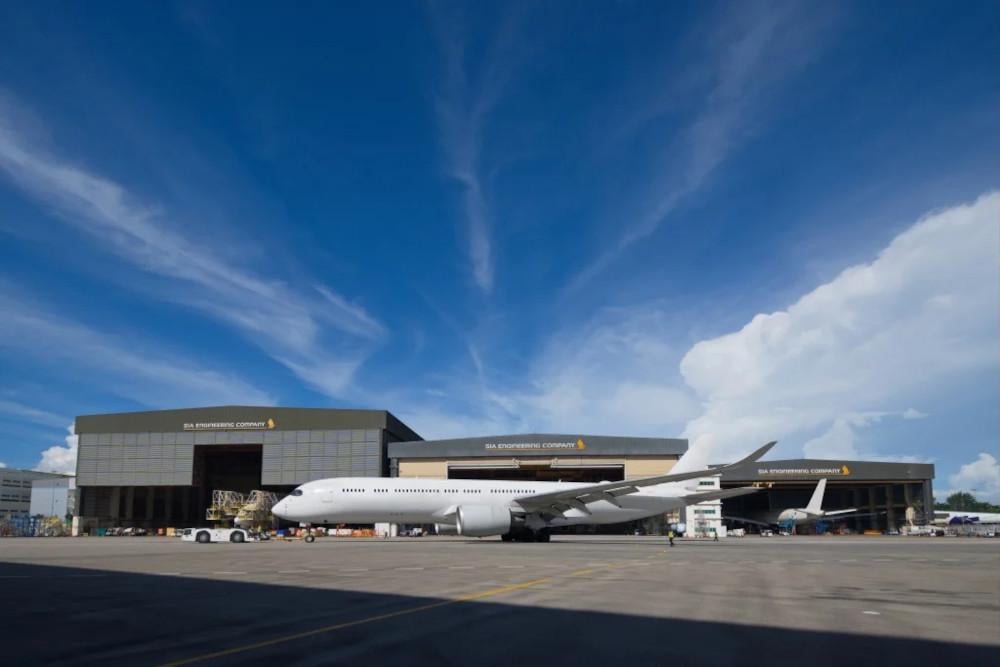
SINGAPORE—MRO providers in Asia-Pacific are pressing ahead with facility expansion plans while investing in digital tools and labor as they seek solutions for the region’s continuing capacity constraints.
Speaking on a panel at Aviation Week Network’s MRO Asia-Pacific conference in Singapore last week, Jeremy Yew, senior vice president of base maintenance at SIA Engineering Company (SIAEC), said capacity in the market remains tight due to several factors—and the industry is still getting to grips with this environment.
“We have aircraft operating longer than expected because of challenges with airworthiness, necessitating heavier maintenance,” he said. “Some of this maintenance which was deferred from the pandemic period is a factor and we still have challenges ramping up the workforce. And, of course, some of the global supply chain issues are resulting in checks extended beyond original turnaround times to the point that it is cannibalizing some of the extra capacity that we're getting in the market.”
Yew said SIAEC has looked to expand physical capacity at its hangars in Singapore and overseas, but it has also refined some of its internal operations. “We are pushing a lot of the methodologies in our hangars including looking at strengthening of our planning processes, minimizing the wastage and maximizing the touch time of aircraft, to eke out some incremental capacity improvement,” he said.
Another major MRO player from Singapore is ST Engineering, which operates facilities in Asia-Pacific, China, North America and Europe. Tan Eng Shu, executive vice president and head of aerospace MRO, said after opening a new facility in the U.S. last year, ST Engineering has broken ground on a third and fourth MRO hangar there. The two hangars in Pensacola, Florida will be open by 2026. In China this year, it set up a two-bay widebody facility in Guangzhou. It also plans to open its third airframe facility in China through a joint venture with SF Airlines.
While becoming increasingly landlocked, Shue said ST Engineering is currently in the middle of plans to add more base maintenance hangars at its Singapore home base by 2026 via a four-bay widebody facility.
ST Engineering predicts strong CFM International Leap engine demand over the next decade and Shue said it is increasing its engine maintenance capacity in Singapore by one-third to accommodate this uptick.
Also in the engine segment, many airlines are still finding "creative ways to hold back on shop visits, according to Kevin Li, managing director of MTU Maintenance Singapore. “A lot of the airlines are trying to extend the usage of their engines now. We use engine exchanges down to even module stocks. I do see a lot of shop visits being done through all these creative solutions such as an engine exchange. But essentially, as much as an operator wants to have an engine that is running for longer periods, you're still kicking the can down the road where a shop visit is needed.”
Li sees this trend continuing, albeit this is dependent on the performance of the aviation supply chain. “For the next one to two years, the supply chain will be key,” he said. “We do see there's still a constraint, and that's why a lot of airlines are trying to put off shop visits.”
Malaysia-based Asia Digital Engineering (ADE), part of Capital A Berhad with carrier AirAsia, undertakes maintenance checks for the group’s fleet and for third-party customers. ADE is also in a more unique position of managing some of the checks for its airline affiliate, which are outsourced to third-party MRO providers.
ADE CEO Mahesh Kumar identifies two key constraints in the Asia-Pacific region. “One is the slots constraint. Operators find it hard to even get a slot," he said. "The second is turnaround times (TAT). Even if the operator gets the slot, it won’t necessarily help them in terms of TATs.” Kumar noted signs of improvement in the past year but feels it will take time before the market fully recovers.
Last week ADE added more capacity and it is now able to accommodate 14 lines of narrowbody maintenance at its main base in Kuala Lumpur. While this is a welcome expansion to the operation, ADE plans to build another four-line hangar at the site soon.
Although the new facilities will help it keep up with high MRO demand, Kumar noted workforce challenges as another hurdle. “Building a hangar is not the biggest issue, as long as you can find land next to the taxiway," he said. "The real issue is getting the people in and getting them trained, certified and approved.”
Kumar said ADE is fortunate to have strong links with local training schools and licensing programs. The company also sources talent from neighboring countries such as Indonesia, the Philippines and Cambodia.





